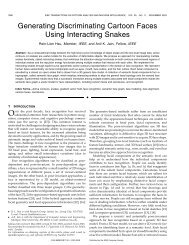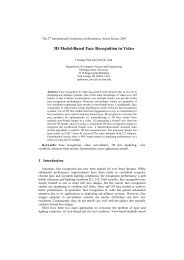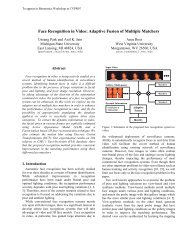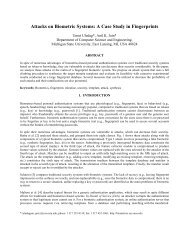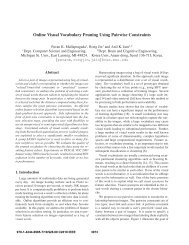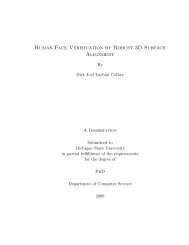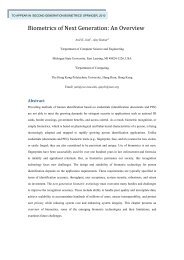Face Detection and Modeling for Recognition - Biometrics Research ...
Face Detection and Modeling for Recognition - Biometrics Research ...
Face Detection and Modeling for Recognition - Biometrics Research ...
Create successful ePaper yourself
Turn your PDF publications into a flip-book with our unique Google optimized e-Paper software.
1.5.1 <strong>Face</strong> Alignment Using 2.5D Snakes<br />
In our first recognition system (shown in Fig. 1.11), we have proposed a face modeling<br />
method which adapts an existing generic face model (a priori knowledge of a human<br />
face) to an individual’s facial measurements (i.e., range <strong>and</strong> color data).<br />
We use<br />
the face model that was created <strong>for</strong> facial animation by Waters [69] as our generic<br />
face model. Waters’ model includes details of facial features that are crucial <strong>for</strong> face<br />
recognition.<br />
Our modeling process aligns the generic model onto extracted facial<br />
features (regions), such as eyes, mouth, <strong>and</strong> face boundary, in a global-to-local way,<br />
so that facial components that are crucial <strong>for</strong> recognition are fitted to the individual’s<br />
facial geometry. Our global alignment is based on the detected locations of facial<br />
components, while the local alignment utilizes two new techniques which we have<br />
developed, displacement propagation <strong>and</strong> 2.5D active contours, to refine local facial<br />
components <strong>and</strong> to smoothen the face model. Our goal of face modeling is to generate<br />
a learned 3D model of an individual <strong>for</strong> verifying the presence of the individual in a<br />
face database or in a video. The identification process involves (i) the modification<br />
of the learned 3D model based on different head poses <strong>and</strong> illumination conditions<br />
<strong>and</strong> (ii) the matching between 2D projections of the modified 3D model, whose facial<br />
shape is integrated with facial texture, <strong>and</strong> sensed 2D facial appearance.<br />
1.5.2 Model Compression<br />
Requirements of easy manipulation, progressive transmission, effective visualization<br />
<strong>and</strong> economical storage <strong>for</strong> 3D (face) models have resulted in the need <strong>for</strong> model<br />
23



